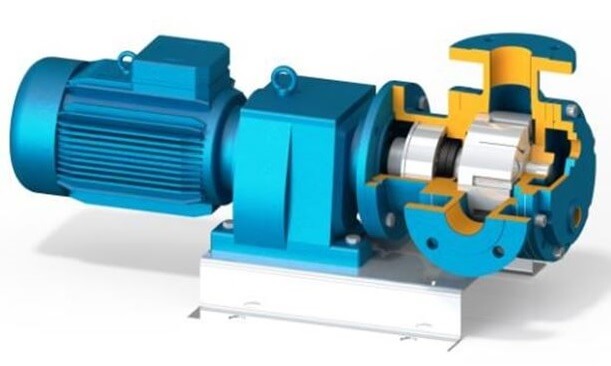Gear pumps are a vital component in numerous industrial applications, appreciated for their efficiency, reliability, and consistent performance. Whether you’re operating in the chemical, oil, or hydraulic industries, chances are gear pumps are at the heart of your operations. But what exactly makes these pumps so reliable, and how do they operate?
This blog will unpack the mechanics of gear pumps, explain their functionality, and explore why they have become the go-to equipment for precision fluid handling needs.
What is a Gear Pump?
A gear pump is a type of positive displacement pump that moves fluid by capturing it between the teeth of rotating gears and the pump casing. This unique mechanism makes gear pumps particularly adept at handling high-viscosity fluids such as oil, adhesives, or chemicals, requiring robust performance under continuous operation. These pumps are known for their ability to deliver a consistent, pulse-free flow, making them indispensable across countless industries.
While large gear pumps often dominate industrial settings, their smaller counterparts, small gear pumps, provide the same reliability and precision in more compact systems. These are frequently used in applications where equipment space is limited but accuracy cannot be compromised.
The Working Principles of Gear Pumps
Understanding how a gear pump works begins with the anatomy of the pump itself. At its core, the pump consists of two gears (a driver gear and an idler gear) housed within a casing. Below is a simplified explanation of the process:
1. Fluid Entry into the Pump (Suction Side)
The pump’s operation begins as the rotation of the gears creates a low-pressure zone on the inlet side of the pump. This suction effect draws the fluid into the pump chamber via the inlet port.
2. Trapping and Transporting Fluid
As the gears rotate, the fluid gets trapped between the teeth of the gears and the inner casing wall. These rotating teeth transport the fluid from the suction side to the discharge side without allowing it to return to the inlet. This feature eliminates backflow, ensuring an efficient and controlled operation.
3. Fluid Discharge
Once the fluid reaches the discharge side, the meshing of the gear teeth forces it out of the pump. The design ensures a smooth and continuous flow, which is ideal for applications requiring steady fluid delivery.
This mechanism minimizes fluid pulsation and delivers exceptional accuracy, making gear pumps ideal for metering and dosing applications.
Key Features That Make Gear Pumps Reliable
Now that we’ve explored how gear pumps work, it’s worth discussing why they’re favored for demanding tasks. Their reliability can be attributed to several distinct features:
1. Precision Engineering
Gear pumps are precisely engineered with tight tolerances, ensuring consistent and accurate fluid movement. The tight clearances reduce the possibility of leakage, even when dealing with low-viscosity or high-pressure systems.
2. Simplicity in Design
One significant advantage of gear pumps is their simplicity. With relatively few moving parts, their design minimizes maintenance requirements and reduces the likelihood of mechanical failure, enhancing their operational lifespan.
3. Compatibility with High-Viscosity Fluids
Unlike some other pump types, gear pumps excel in handling high-viscosity fluids such as lubricating oils, adhesives, and molasses. This makes them indispensable for industries like automotive, food processing, and chemicals.
4. Durability and Longevity
Many gear pumps are built from materials such as cast iron, stainless steel, or bronze, enhancing durability and allowing them to withstand harsh operating environments. Their rugged design ensures longevity even under continuous use.
5. Compact Options
For smaller systems or applications requiring portable equipment, compact, small gear pumps deliver the same performance capabilities as larger versions, making them ideal for tailored or space-restricted setups.
6. Self-Priming Capability
A defining feature of gear pumps is their ability to self-prime. This means they can easily remove air from the pump chamber, ensuring a smooth start-up.
Applications of Gear Pumps Across Industries
The versatility of gear pumps is reflected in their widespread use across various industries. Here’s a look at some notable applications:
1. Oil and Gas Industry
Gear pumps are commonly used for transferring high-viscosity oils and lubricants in oil extraction and refinery operations. Their ability to handle extreme temperatures and pressures makes them indispensable in these environments.
2. Chemical Processing
Precision is a non-negotiable requirement in chemical processing plants. Here, gear pumps are utilized to transport and meter chemicals with consistent accuracy, ensuring safe and controlled operations.
3. Food and Beverage Production
Gear pumps are often employed to handle viscous liquids like syrups, chocolate, or oils in food production facilities. Built from food-grade materials, they offer hygienic and reliable operation.
4. Hydraulic Systems
Hydraulic gear pumps play a crucial role in powering machinery such as forklifts and industrial presses by moving hydraulic fluids efficiently and effectively.
5. Pharmaceutical and Cosmetics Industry
Small gear pumps are used in the pharmaceutical and cosmetic sectors to ensure precision during filling, dosing, and manufacturing. Their precision reduces wastage and ensures consistent product quality.
Gear Pumps Vs. Other Pump Types
While gear pumps offer many advantages, it’s important to note how they differ from other types, such as centrifugal or diaphragm pumps.
| Feature | Gear Pumps | Centrifugal Pumps | Diaphragm Pumps |
| Best for | High-viscosity, precise dosing | High flow rates | Corrosive, abrasive fluids |
| Flow Pulsation | Minimal | Moderate pulsation | Visible pulsation |
| Self-Priming | Yes | No | Yes |
| Maintenance | Low | Moderate | Higher maintenance required |
This highlights gear pumps’ niche for precision and their compatibility with challenging liquids, setting them apart as essential tools in various sectors.
Picking the Right Gear Pump
Choosing the right gear pump, whether large-scale or compact, involves understanding the specific requirements of your application. Consider factors such as fluid viscosity, operating temperature, and pressure, as well as material compatibility. Always consult with a trusted manufacturer or supplier for recommendations tailored to your unique needs.
Discover the Precision and Reliability of Gear Pumps
Gear pumps have earned their reputation as some of the most reliable and versatile tools in modern industry. Their simple yet effective mechanism and capability to handle demanding applications make them indispensable across multiple sectors. Whether you need high-volume pumping or precision delivery in a small system, gear pumps offer the technology and flexibility to meet your needs.
Explore how small gear pumps could work for your specific applications, and unlock unparalleled operational efficiency. With the right gear pump, optimized performance is within your reach.


